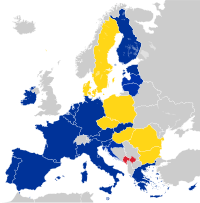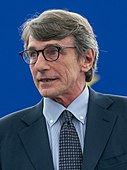President of the European Union: Difference between revisions
ArcMachaon (talk | contribs) Fix update tag Tags: Mobile edit Mobile web edit Advanced mobile edit |
Valenciano (talk | contribs) →Election: now 27 EU member states |
||
| Line 19: | Line 19: | ||
The Presidents of each institution are chosen in a slightly different way; |
The Presidents of each institution are chosen in a slightly different way; |
||
* The President of the European Parliament is elected from among [[Member of the European Parliament|MEPs]] for a 2.5 year, renewable term.<ref name="EUROPA-EU Presidents" /> |
* The President of the European Parliament is elected from among [[Member of the European Parliament|MEPs]] for a 2.5 year, renewable term.<ref name="EUROPA-EU Presidents" /> |
||
* The President of the European Council is elected by the heads of state/government of the |
* The President of the European Council is elected by the heads of state/government of the 27 EU member states for a 2.5 year, once renewable term.<ref name="EUROPA-EU Presidents" /> |
||
* The President of the European Commission is officially proposed by the European Council, taking into account the [[Elections in the European Union|latest European Parliament elections]] and subsequently elected by the European Parliament for a 5 year, renewable term.<ref name="EUROPA-EU Presidents" /> However, a stronger direct link between elections and the President is emerging.<Ref>[https://euobserver.com/opinion/138570 Winter is here for Spitzenkandidat, but he'll survive], EUObserver 20 July 2017</ref> |
* The President of the European Commission is officially proposed by the European Council, taking into account the [[Elections in the European Union|latest European Parliament elections]] and subsequently elected by the European Parliament for a 5 year, renewable term.<ref name="EUROPA-EU Presidents" /> However, a stronger direct link between elections and the President is emerging.<Ref>[https://euobserver.com/opinion/138570 Winter is here for Spitzenkandidat, but he'll survive], EUObserver 20 July 2017</ref> |
||
* The Presidency of the Council of the European Union rotates automatically between the governments of each member state every 6 months.<ref name="EUROPA-EU Presidents" /> |
* The Presidency of the Council of the European Union rotates automatically between the governments of each member state every 6 months.<ref name="EUROPA-EU Presidents" /> |
||
Revision as of 08:42, 1 February 2020
| This article is part of a series on |
 |
|---|
|
|

The official title President of the European Union (or President of Europe) does not exist, but there are a number of presidents of European Union institutions, including:
- the President of the European Council (since 1 December 2019, Charles Michel)
- the President of the European Commission (since 1 December 2019, Ursula von der Leyen)
- the President of the European Parliament (since 3 July 2019, David Sassoli)
Alongside these the Council of the European Union (also known as the Council of Ministers or simply "the Council") containing 28 national ministers, one of each nation, rotates its presidency by country. This presidency is held by a country, not a person; meetings are chaired by the minister from the country holding the presidency (depending on the topic, or "configuration"), except for the Foreign Affairs Council (one so-called "configuration" of the Council of the EU), which is usually chaired by the High Representative of the Union for Foreign Affairs and Security Policy.[1] The Presidency of the Council of the European Union has been held by Croatia since 1 January 2020.[needs update]
According to protocol, it is the President of the Parliament who comes first, as it is listed first in the treaties.[2] However, on the world stage, the principal representative of the EU is considered to be the President of the European Council,[3] but the President of the European Commission, as head of the executive branch of the European Union, takes part in the G7 and other international summits as well.[1]
In media
All four offices have been described as the President of Europe, but none are analogous to the President of the United States (who is both head of state and head of government). Comparisons with other political system have attempted to explain the complex nature of the European institutions. As each institution has its own leader, it has been suggested that the terms "Speaker" of the European Parliament, "Governor" of the European Central Bank, "Chairman" of the Council of the European Union, "President" of the European Council and "Prime Commissioner" would give a clearer indication of their respective roles.[4]
During the height of the Commission President's powers in the late-1980s and 1990s, the Commission President was sometimes referred to as the Europe's Prime Minister[5][6] and the role of the President is similar to that of a national Prime Minister chairing a cabinet.[7][full citation needed] The formulation of titles is not without precedent in Europe; for comparison, the title for the Prime Minister of Spain in Spanish is the Presidente del Gobierno ("President of the Government"), not Prime Minister.[8][9]
Election
The Presidents of each institution are chosen in a slightly different way;
- The President of the European Parliament is elected from among MEPs for a 2.5 year, renewable term.[1]
- The President of the European Council is elected by the heads of state/government of the 27 EU member states for a 2.5 year, once renewable term.[1]
- The President of the European Commission is officially proposed by the European Council, taking into account the latest European Parliament elections and subsequently elected by the European Parliament for a 5 year, renewable term.[1] However, a stronger direct link between elections and the President is emerging.[10]
- The Presidency of the Council of the European Union rotates automatically between the governments of each member state every 6 months.[1]
Roles

Whilst distinct, each president is required to closely co-operate with one another in a complex political system.[citation needed] Under the ordinary legislative procedure of the European Union, the Commission proposes legislation with the Parliament and Council of the European Union coming to a co-decision on amendments and adoption of the law. The president of each of these organs is generally held responsible their functioning and direction.[citation needed]
President of the European Council
The president of the European Council is considered the principal representative of the EU internationally and diplomatically.[3] They are required to lead the Council, which works to set the EU's general political direction and promote compromise and consensus within the Council. They are appointed by the appropriate national leaders in the European Council.[1]
Prior to the Treaty of Lisbon, each member state in turn took the responsibilities of both the Presidency of the European Council and the Presidency of the Council of the European Union, with the representative to the European Council of the respective member state currently occupying the Presidency of the Council of the EU chairing meetings of the European Council. However, the title and office "President of the European Council" or any analogous position, did not exist prior to the Treaty of Lisbon, despite frequent misleading journalistic use of the shorthand tag "EU President"[nb 1] to refer to the leader of the member state occupying the rotating Presidency of the Council of the European Union. The misleading shorthand tag "EU Presidency" is still used by press today to refer to the member state holding the rotating Presidency of the Council of the European Union.
President of the European Commission
The president of the European Commission leads the Commission, the executive and cabinet of the European Union. The president, as part of this institution, is responsible for the political direction, logistics and implementation of European law and held accountable to both the European Parliament and Council of the European Union.[1]
The role gives the holder the right to allocate portfolios to, dismiss and reshuffle European Commissioners and direct the Commission's civil service. The president is nominated by the European Council and appointed by the European Parliament.[1] It is customary that the European Council uses the result of the last European elections to guide their nomination.
President of the European Parliament
The president of the European Parliament ensures proper parliamentary procedure is followed and is responsible for representing the Parliament in both legal and diplomatic settings. The president must also give final assent to the EU budget.[1]
Gallery
See also
- List of presidents of the institutions of the European Union
- Presidency of the Council of the European Union
Further reading
- Nedergaard, Peter; Jensen, Mads Dagnis (September 2014). "Uno, duo, trio? Varieties of trio presidencies in the Council of Ministers". Journal of Common Market Studies. 52 (5): 1035–1052. doi:10.1111/jcms.12130.
{{cite journal}}: Invalid|ref=harv(help)
Notes
References
- ^ a b c d e f g h i j "EU Presidents – who does what? - European Union - European Commission". European Union. 16 June 2016. Retrieved 14 November 2017.
- ^ 9.5. Administrative structure of the European Union: official titles and listing order, European Commission
- ^ a b Treaty of Lisbon amending the Treaty on European Union and the Treaty establishing the European Community, Article 9 B
- ^ ‘The European Union: How Does it Work?' (3rd ed) Elizabeth Bomberg, John Peterson and Richard Corbett (2012, Oxford University Press) ISBN 978-0-19-957080-5 and ISBN 0-19-957080-9
- ^ James, Barry (16 April 1999). "Prodi to Have Wide, New Powers as Head of the European Commission". International Herald Tribune. Archived from the original on 17 October 2007. Retrieved 17 June 2007.
- ^ Rossant, John (27 September 1999). "Commentary: Romano Prodi: Europe's First Prime Minister? (int'l edition)". Business Week. Retrieved 17 June 2007.
- ^ Hix 2008, p. 155.
- ^ Official web site of La Moncloa, the Spanish Prime Minister's Office Accessed 2009-03-05
- ^ The Oxford Spanish Dictionary and Grammar, ed. C.Lea et al., 2nd ed.(2001)
- ^ Winter is here for Spitzenkandidat, but he'll survive, EUObserver 20 July 2017
- ^ "EU heads put constitution on hold". BBC News. 16 June 2005. Retrieved 2 December 2019.
[...]EU President Jean-Claude Juncker said after talks in Brussels.
- ^ "EU Executive Commission resigns over report - Mar. 15, 1999". CNN. 15 March 1999. Retrieved 2 December 2019.
He said Santer would meet current EU president, German Chancellor Gerhard Schroeder, in Brussels later Tuesday [...]
- ^ Gordon, Stephanie (12 December 2002). "EU policy creating brain drain to U.S". EETimes. Retrieved 2 December 2019.
The letter, obtained by Reuters, was sent to the current EU president, Danish Prime Minister Anders Fogh Rasmussen, before a December 12-13 EU summit in Copenhagen.
External links







